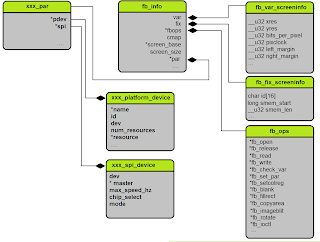Hello
Today I will describe my LCD module driver for ST7565. This driver based on fbtft library solution created by Noralf Tronnes.
As I mentioned in a previous post the frame buffer is the intermediate layer
between higher kernel layers and video drivers. The frame
buffer provider general abstraction to handle all forms of video device.
Our device can communicate with system via different types of bus ( eg.
SPI, I2C or parallel ) therefore we have to link specific bus driver with frame
buffer interface. Below we can see "par" structure where "xxx platform
device" or "xxx spi device" can be plug in.
"xxx platform device" is a device defined in platform specific
files, used to parallel bus connection.
"xxx spi device" is a spi device driver.
"xxx spi device" is a spi device driver.
The Linux device model is based on bus and device concepts. More
information you can find o
The frame buffer is a platform specific segment of the system. The most
popular implementation for Raspberry Pi is Fbtft created by Noralf Tronnes. More information you can find here
https://github.com/notro/fbtft/wiki
I decided to use fbtft because all frame buffer interface methods are
implemented and my job was only to create a new device file with a few methods to
implement a specialized interface for st7565 driver.
The most important methods are:
- static int init_display(struct fbtft_par *par) - executed during
initialization in fbtft_register_framebuffer implemented in fbtft
library.
- static int write_vmem(struct fbtft_par *par, size_t offset, size_t len) -
executed
during screen refreshing process. This function is taking a picture image
from video memory buffer and convert it to appropriate to display device
format. In my case video memory buffer have a format RGB 565 (16 bpp) with
screen resolution 132 x 64. Because my LCD has only two colors I convert 16 bpp
video memory format to 2bpp device format black and white. Conversion RGB
565 to 2bpp pattern is simple: zero values cast to black pixels and all the
other to white pixels.
Last thing to do is prepare fbtft_display structure, in this structure we
define parameters which are passed to fb_var_screeninfo and fb_fix_screeninfo structures.
Second thing is our device specific operation which are assigned to fbtftops
structure:
static struct fbtft_display display = {.regwidth = 8,.width = WIDTH,.height = HEIGHT,.txbuflen = TXBUFLEN,.gamma_num = 1,.gamma_len = 1,.gamma = DEFAULT_GAMMA,.fbtftops = {.init_display = init_display,.set_addr_win = set_addr_win,.set_var = set_var,.write_vmem = write_vmem,.set_gamma = set_gamma,},.backlight = 1,};
You can find all code on this repository :
https://github.com/zanaster/fbtft
Ok - and this is result of my work :


